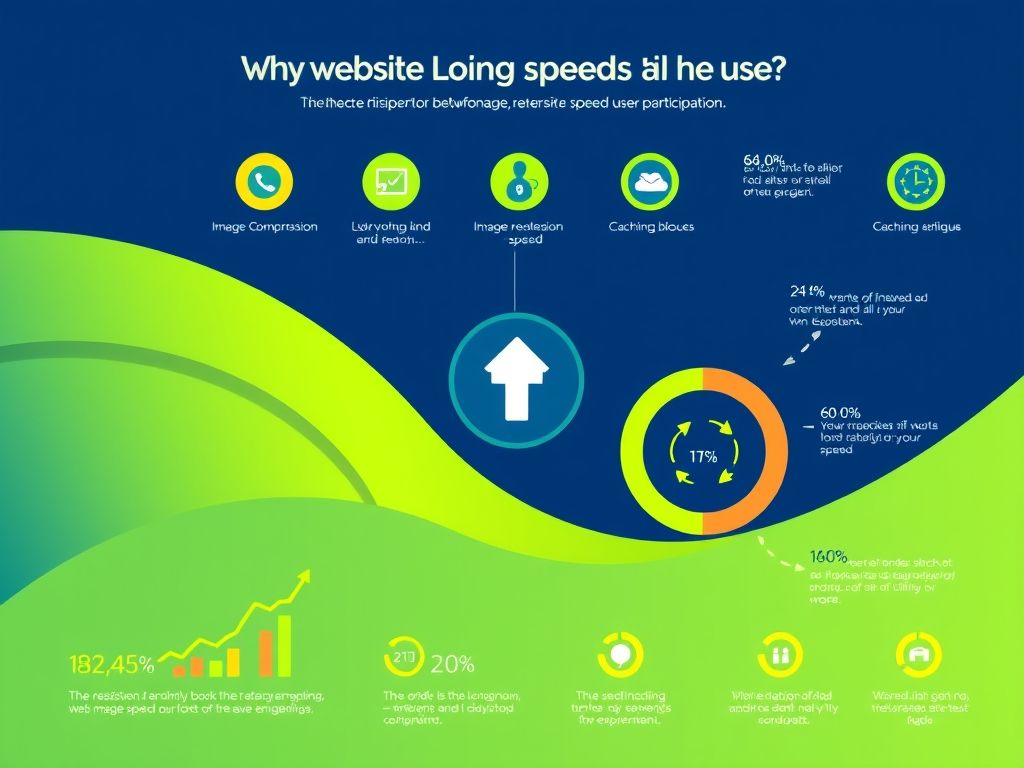In today’s fast-paced digital world, website loading speed is crucial for user experience and search engine rankings. A slow website can lead to lost customers and missed opportunities. This guide will explore how to optimize your website for speed using the best practices and strategies, ultimately improving user engagement and search engine visibility.
Understanding Website Performance
Website speed is no longer just a technical detail; it’s a critical factor influencing everything from search engine rankings to user satisfaction and, ultimately, your bottom line. Understanding the various elements that contribute to website performance is the first step towards achieving a fast and efficient online presence. Several key factors play a significant role in determining how quickly your website loads for visitors. Let’s delve into these aspects:
Server Response Time
The server response time is the time it takes for your website’s server to respond to a request from a user’s browser. A slow server response time can significantly delay the loading of your website. Several factors can contribute to a slow server response, including:
- Server Hardware: Outdated or underpowered server hardware can struggle to handle the demands of your website, especially during peak traffic periods.
- Server Location: The physical distance between your server and your users can impact response time. The further away your server is, the longer it takes for data to travel.
- Server Configuration: Incorrectly configured server settings can lead to bottlenecks and slow performance.
- Traffic Volume: High traffic volume can overwhelm your server, leading to slower response times for all users.
Improving server response time often involves upgrading server hardware, optimizing server configuration, and potentially using a Content Delivery Network (CDN) to distribute your website’s content across multiple servers closer to your users.
Image Optimization
Images often constitute a large portion of a website’s total file size. Unoptimized images can significantly slow down loading times. Image optimization involves reducing the file size of images without sacrificing visual quality. Techniques for image optimization include:
- Image Compression: Using compression algorithms to reduce the file size of images.
- Resizing Images: Ensuring that images are appropriately sized for their intended display area. Avoid using unnecessarily large images.
- Choosing the Right File Format: Using appropriate image formats, such as JPEG for photographs and PNG for graphics with transparency.
- Lazy Loading: Implementing lazy loading, which only loads images when they are visible in the user’s viewport.
Effective image optimization is crucial for improving website speed and enhancing user experience. It’s a key area for tối ưu hoá.
Code Efficiency
Inefficient code can also contribute to slow website loading times. Clean, well-structured code is essential for optimal performance. Factors that affect code efficiency include:
- Code Bloat: Unnecessary or redundant code can increase file sizes and slow down parsing and execution.
- JavaScript Execution: Excessive or poorly optimized JavaScript can block rendering and delay the loading of other website elements.
- CSS Delivery: Unoptimized CSS can also impact rendering performance. Minifying and compressing CSS files can improve loading times.
Improving code efficiency involves removing unnecessary code, optimizing JavaScript execution, and ensuring efficient CSS delivery. Good coding practices are essential for lập trình nhanh and effective website performance.
Importance of Website Speed for SEO
Website speed is a significant ranking factor for search engines like Google. Search engines prioritize websites that provide a good user experience, and a fast-loading website is a key component of that experience. Websites that load quickly tend to rank higher in search results, leading to increased visibility and organic traffic. Furthermore, slow loading times can increase bounce rates, signaling to search engines that your website is not providing a satisfactory experience. Investing in website speed optimization is therefore crucial for improving your SEO performance.
Importance of Website Speed for User Experience
Beyond SEO, website speed is critical for user experience. Users expect websites to load quickly, and they are likely to abandon a website that takes too long to load. Slow loading times can lead to frustration, decreased engagement, and ultimately, lost customers. A fast-loading website, on the other hand, provides a smooth and enjoyable user experience, leading to increased engagement, higher conversion rates, and improved customer satisfaction. Therefore, cải thiện hiệu suất is directly linked to improving user experience.
In conclusion, understanding the factors that affect website loading speed is paramount for achieving optimal performance. By addressing server response time, optimizing images, and ensuring code efficiency, you can significantly improve your website’s speed, which in turn will boost your SEO and enhance user experience. Optimizing for Fast Loading requires a proactive approach to identify and address performance bottlenecks.
Optimizing for Fast Loading
Following our discussion in “Understanding Website Performance” about the factors affecting website loading speed, like server response time, image optimization, and code efficiency, this chapter delves into actionable steps you can take to drastically improve your website’s performance. We’ll cover techniques for image compression, caching strategies, code minification, the benefits of using a Content Delivery Network (CDN), and how to choose the right hosting provider.
One of the most significant contributors to slow loading times is unoptimized images. Large image files consume bandwidth and increase the time it takes for a page to fully load. The first step is **image compression**. *This reduces the file size without significantly impacting the visual quality.* Tools like TinyPNG, ImageOptim (for Mac), and ShortPixel can automatically compress images. Remember to use appropriate image formats; JPEG is suitable for photographs, while PNG is better for graphics with sharp lines and text. WebP is a modern image format that offers superior compression and quality compared to JPEG and PNG, but ensure browser compatibility.
Next, let’s consider **caching strategies**. Caching involves storing frequently accessed data so that future requests for that data can be served faster. Browser caching allows the user’s browser to store static assets like images, CSS, and JavaScript files locally. When the user revisits the page, these assets are loaded from the browser’s cache instead of the server, resulting in significantly faster loading times. Implement browser caching by setting appropriate HTTP headers. Server-side caching, on the other hand, stores dynamic content on the server, reducing the load on the database and improving response times. Technologies like Varnish and Redis can be used for server-side caching. **Tối ưu hoá** caching is crucial for a fast website.
Another critical aspect is **code minification**. Minification removes unnecessary characters from your HTML, CSS, and JavaScript files, such as whitespace, comments, and line breaks. This reduces the file size, leading to faster download times. Tools like UglifyJS (for JavaScript) and CSSNano (for CSS) can automate this process. In addition to minification, consider combining multiple CSS and JavaScript files into fewer files. *Each file requires a separate HTTP request, so reducing the number of requests can significantly improve loading speed.*
A Content Delivery Network (CDN) is a geographically distributed network of servers that caches your website’s static content and delivers it to users from the server closest to their location. This reduces latency and improves loading times, especially for users located far from your origin server. Using a CDN is particularly beneficial if your website has a global audience. Popular CDN providers include Cloudflare, Akamai, and Amazon CloudFront. The benefits of using a CDN are numerous, including faster loading times, reduced bandwidth costs, and improved website availability. Choosing the right CDN depends on factors such as cost, performance, and features.
Choosing the right hosting provider is also essential for optimal website performance. Shared hosting is the most affordable option, but it can also be the slowest due to shared resources. Virtual Private Servers (VPS) offer more resources and control than shared hosting, but they require more technical expertise to manage. Dedicated servers provide the highest level of performance and control, but they are also the most expensive. Cloud hosting offers scalability and flexibility, allowing you to easily scale your resources up or down as needed. When choosing a hosting provider, consider factors such as server location, uptime guarantee, customer support, and available resources. **Lập trình nhanh** often requires a robust hosting environment.
Finally, consider lazy loading for images and videos. Lazy loading defers the loading of off-screen images and videos until they are about to enter the viewport. This reduces the initial page load time and improves the user experience. Implement lazy loading using JavaScript libraries or native browser features like the `loading` attribute.
By implementing these strategies, you can significantly improve your website’s loading speed and provide a better user experience. Remember that website speed is an ongoing process, and it’s important to continuously monitor your website’s performance and make adjustments as needed. **Cải thiện hiệu suất** is an iterative process.
Building on these optimization techniques, the next chapter, “Continuous Performance Monitoring,” will detail the importance of monitoring website performance and using tools to track key metrics like page load time and server response. We’ll also discuss how to identify and resolve performance bottlenecks and suggest methods for improving website speed over time.
Following our discussion on Optimizing for Fast Loading, where we explored techniques like image compression, caching strategies, and code minification, and the benefits of using a CDN, it’s crucial to understand that website optimization is not a one-time fix. It’s an ongoing process that requires constant vigilance and adaptation. This leads us to the next critical step: Continuous Performance Monitoring.
Continuous Performance Monitoring
A website, much like a finely tuned engine, requires regular checks to ensure it’s running at peak efficiency. Continuous performance monitoring is the process of regularly tracking key metrics to identify potential problems and proactively address them. Without it, even the most meticulously *optimized* website can slowly degrade in performance, leading to frustrated users and lost business.
Why is this so important? Websites are dynamic entities. Content changes, traffic fluctuates, and third-party services can impact performance unexpectedly. Monitoring provides the data needed to understand these changes and respond effectively. This is where the concept of **Lập trình nhanh** (fast programming) comes into play. While it might seem counterintuitive, focusing on long-term maintainability and monitorability during development allows for faster identification and resolution of performance issues down the line.
Here are some key metrics you should be tracking:
- Page Load Time: This is the most crucial metric. It measures the time it takes for a page to fully load in a user’s browser. Aim for a load time of under 3 seconds. Tools like Google PageSpeed Insights, GTmetrix, and WebPageTest can provide detailed insights into your page load time and identify areas for improvement.
- Server Response Time: This measures the time it takes for your server to respond to a request from a user’s browser. A slow server response time can indicate problems with your hosting infrastructure or backend code.
- Time to First Byte (TTFB): TTFB measures the time it takes for the first byte of data to be received from the server. It’s a good indicator of server responsiveness and network latency.
- Error Rates: Monitoring error rates, such as 404 errors and 500 errors, can help you identify problems with your website’s functionality and user experience.
- Bounce Rate: While not directly related to website speed, a high bounce rate can indicate that users are leaving your website quickly, which could be due to slow loading times or a poor user experience.
Tools for Performance Monitoring:
Several tools are available to help you monitor your website’s performance. Some popular options include:
- Google Analytics: Provides basic website traffic and performance data.
- Google PageSpeed Insights: Analyzes your website’s speed and provides recommendations for improvement.
- GTmetrix: A comprehensive performance analysis tool with detailed reports and recommendations.
- WebPageTest: A powerful tool for testing website performance from different locations and browsers.
- New Relic: A comprehensive application performance monitoring (APM) tool.
- Pingdom: A website monitoring service that tracks uptime, page load time, and other key metrics.
Identifying and Resolving Performance Bottlenecks:
Once you’ve established a system for monitoring your website’s performance, the next step is to identify and resolve any bottlenecks. This often requires a combination of data analysis and troubleshooting. For example, if you notice that your page load time is consistently slow, you can use tools like Google PageSpeed Insights to identify the specific elements that are causing the delay. This might include large images, unoptimized code, or slow-loading third-party scripts.
The goal is **Cải thiện hiệu suất** (improve performance). This involves a systematic approach to identifying the root causes of performance issues and implementing solutions to address them. This might involve *optimizing* images, minifying code, leveraging browser caching, or upgrading your hosting infrastructure. Remember the principles of **Tối ưu hoá** (optimization) discussed earlier.
Improving Website Speed Over Time:
Website speed improvement is not a one-time task but an iterative process. Regular monitoring and analysis will reveal new areas for improvement as your website evolves. Continuously review your website’s performance data, identify trends, and implement changes to address any emerging bottlenecks. Stay up-to-date with the latest web performance best practices and technologies, and adapt your strategies accordingly.
By consistently monitoring your website’s performance and proactively addressing any issues, you can ensure that it remains fast, responsive, and user-friendly, providing a positive experience for your visitors and contributing to your overall online success.
Conclusions
By implementing these optimization strategies, you can significantly improve your website’s loading speed, leading to a better user experience, higher search engine rankings, and ultimately, increased conversions. Regular monitoring and adjustments are key to maintaining optimal performance.











